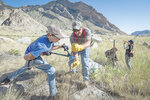Clear, 47° F
In celebration of the 30th anniversary of National Public Lands Day, the Bureau of Land Management Cody Field Office and the Absaroka Fence Initiative called on their growing list of volunteers to …
This item is available in full to subscribers.
The Powell Tribune has expanded its online content. To continue reading, you will need to either log in to your subscriber account, or purchase a subscription.
If you are a current print subscriber, you can set up a free web account by clicking here.
If you already have a web account, but need to reset it, you can do so by clicking here.
If you would like to purchase a subscription click here.
Please log in to continue |
|



In celebration of the 30th anniversary of National Public Lands Day, the Bureau of Land Management Cody Field Office and the Absaroka Fence Initiative called on their growing list of volunteers to make the fences at the Clarks Fork Canyon watershed more big game friendly.
BLM workers from Cody, some of them also on the steering committee of the initiative, organized the volunteer work day to make adjustments to existing fences to alter them to provide for both livestock management and wildlife population management — especially big game.
Bighorn sheep, mountain goats, elk and deer all are common in the canyon. Yet the fencing on the BLM portion of the property was too restrictive to their movement. The top strand of the barbed-wire fences in the mouth of the canyon were too high (about 4 feet) for elk and deer to jump over and needed to be lowered to 38 inches. At the same time, the bottom strand was too low (about 1 foot) and needed to be replaced with barbless strands and raised to a height that allows sheep, pronghorns, calves and fawns to safely cross. The configuration is still effective for livestock rotations, said Alicia Hummel, range specialist at the BLM and chair of the initiative’s steering committee.
Working in cooperation with willing landowners and land managers, Absaroka Fence Initiative aims to ensure fences are functional for livestock management and wildlife movement across the landscape through on-the-ground projects, public workdays and outreach to the community.
When the group first started, there were few volunteers joining in. Now dozens are committing their time to the project.
“Every project gets bigger. We had 50 people sign up,” Hummel said. “We are extremely appreciative for the [donors] who have granted us money and for the volunteers that continue to show up.”
“The community is great,” said BLM wildlife biologist Destin Harrell. “They come out, they volunteer, and we've had project after project over the years, where our volunteers are becoming better and better at fencing. And we're becoming more effective. We're accomplishing more and more miles of fence. And it's really adding up to have great benefits to the big game populations.”
The canyon’s reputation for some of the region’s most fierce wind held true for the duration of the project, but that didn’t stop Boy Scout Tenderfoot Richard Watts from volunteering for the group. His troop volunteered for the first project in Clark, when he was 10, and he hasn’t missed an event in three years.
“I like helping animals. And I think it's very nice for them to be able to move freely under and over fences,” he said.
He not only is ready to and willing to put in the hard work, but he also brought a new volunteer — his father Carl Watts.
“[Richard] invited me this year. It's a great day to spend a Saturday with my son,” he said, promising to continue joining his son in community service with the group.
The initiative is made up of landowners, community members, non-governmental organizations and local government agencies in Park County. Representatives from the Shoshone National Forest, BLM, Wyoming Game and Fish Department, the Greater Yellowstone Coalition, The Nature Conservancy, Draper Natural History Museum, Meeteetse Conservation District, Wyoming Migration Initiative, Powell’s Natural Resources Conservation Service and private companies are on the steering committee.
National Public Lands Day has grown into the largest single-day volunteer event for the care and celebration of our public lands. Held on the fourth Saturday in September annually, it celebrates the connection between people and green space in their community, inspires environmental stewardship, and encourages use of open space for education, recreation, and health benefits, according to the National Park Service.